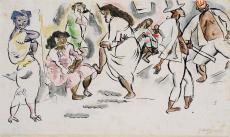


Julius Mordecai Pincas, known as Jules Pascin, an anagram of his family name, was born in Bulgaria. When he arrived in Paris in 1905, the year the Fauves caused a scandal at the Salon d’Automne, he was already known from the drawings he contributed to the German satirical journal Simplicissimus. He soon established himself as the roguish chronicler of the nights of Montparnasse and Montmartre, where he lived across from the studio of Kees van Dongen (1877-1968). His drawings and his watercolours were exhibited at the Salon d’Automne. Forced to leave France in 1914 because of his nationality, he sailed to the United States, where he became an American citizen in 1920.
A resident of New York, where he was befriended by the photographer and gallery owner Alfred Stieglitz (1864-1946), Pascin travelled frequently, making drawings and watercolours in Texas, Florida, Cuba and of the Mardi Gras in New Orleans. The watercolour drawing in the A. G. Leventis Collection is a particularly welcome example of the cursive and mordant style of the painter as amused observer of the working-class streets of Havana, Cuba. This charming work, which can be dated to c. 1916-1917, shows Pascin’s taste for a syncopated, spontaneous line in the case of female figures and strongly ‘Cubist’ rhythms in the case of male figures. In fact, Pascin was briefly influenced by the experiences of the Parisian Cubists. This watercolour drawing was not included in the painter’s catalogue raisonné, but one of its authors, Abel Rambert, was kind enough to confirm its authenticity, by stressing that the handwritten signature on the sheet of watercolour paper leads us to understand that this street scene was probably sold by the painter during his lifetime, and that he considered it a completed work.
After World War I Pascin returned to France, and it was the account of their meeting in the spring of 1924 that inspired Ernest Hemingway to write A Moveable Feast, in which Pascin is depicted as a dissolute Montparnasse dandy. Pascin later continued to travel, in Southern Europe and North Africa. Suffering from alcoholism and depression, he committed suicide on June 1930, at the age of 45.
Nicknamed the ‘Prince of Montparnasse’ both for his bohemian lifestyle and his depictions of the area and its demi-monde, he was born in Bulgaria and settled in Paris in 1905. He created countless delicately drawn oils, watercolours and sketches, as well as satirical drawings and caricatures for newspapers and magazines.